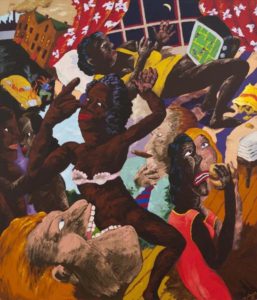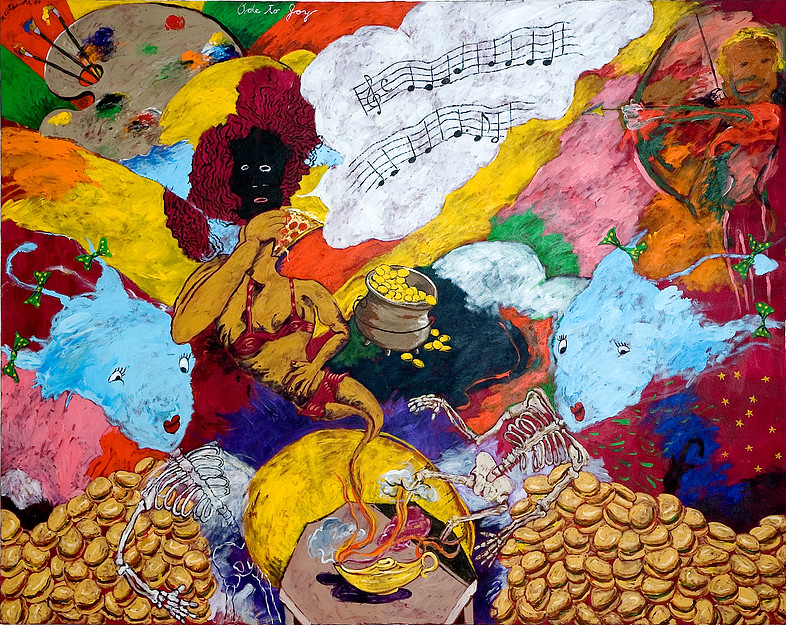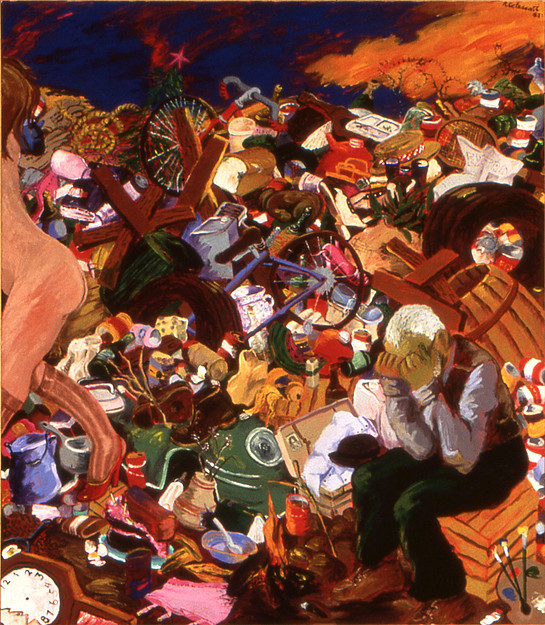
Robert Colescott (1925-2009)in Figuratively Speaking, Michael Rosenfeld Gallery New York, until January 20, 2018.
Pac Man, The Consumers Consumed, 1988.
“I was one of the first to use appropriation in a way that might be called postmodern…But most artists who appropriate do it as some sort of homage to an artist they admire. Mine was no homage. I wanted to dominate that other artist.”[1]
“If you decide to laugh, don’t forget the ‘humor is the bait,’ and once you’ve bitten, you may have to do some serious chewing. The tears may come later.”[2]
Robert Colescott was born in Oakland, California in 1925 to parents who had experienced first-hand the frustration of the limited opportunities available to talented black men and women in the Jim Crow South. His father was a violinist who had fought in France with the segregated 92nd Division during the First World War before taking a job as as a waiter on the Southern Pacific railway. His mother, a pianist, had been a teacher in New Orleans but was forced to resign when she married because schools would not allow married women to teach. In 1919, his parents left Louisiana for Oakland, choosing California in part so that their future children would have access to an integrated, rigorous, and affordable university education.[3] Colescott grew up in a diverse neighborhood in a middle-class household that nurtured his intellect as well as his love of music and drawing. His parents were part of a small but significant black cultural community that included artist Sargent Claude Johnson, a family friend who would support and encourage Colescott’s artistic ambitions as he got older.[4]

Ode to Joy, 1997.
When Colescott finished high school in 1942, he volunteered for the US Army, serving in Europe and the Pacific. Upon his return, he used funding from the GI Bill to attend San Francisco State University, where he intended to study international relations and economics. Although he had been drawing and painting since childhood, he never saw art as a potential career.[5] But his outlook changed when a college counselor advised Colescott not to pursue international relations because a career with the State Department was unlikely for African Americans. At the time, he was taking a class with abstract expressionist painter Edward Corbett, and now, forced to rethink his entire course of study, Colescott decided to pursue his love of art. In 1946, he transferred to the University of California, Berkeley. Colescott’s undergraduate years coincided with the height of gestural abstraction, and Berkeley was a west coast center of abstract art. When he finished his BFA in 1949, Colescott was working primarily in an abstract style. After graduation, he traveled to Paris with the intention of studying with Fernand Léger, but Léger refused to look at Colescott’s portfolio because it consisted of abstract work. However, he did take Colescott into his small group of students. Léger had a profound influence on Colescott, encouraging him to question the dominance of abstract expressionism. In 1950, Colescott returned to California to pursue his MFA at Berkeley. Now in agreement with Léger that abstraction was ineffective for communicating ideas to a general public, Colescott was one of the few figural painters among such dedicated abstractionists as Jay DeFeo and Sam Francis. He soon turned to painting’s past for inspiration.

Showtime, 1996.
In the early 1950s, Colescott finished his MFA and moved to Seattle, where he taught junior high school during the day and dedicated the rest of his time to painting: “After dinner I’d go down to my basement studio and paint until 2 and 3 in the morning. I accepted the fact that I taught, but I wouldn’t accept the fact of being a teacher….I wanted to solve the problems of paint. I kept trying to learn how to use my brush with some sense of strength and energy and personality, and so I painted all kinds of things: I painted figures, I painted still lifes, I painted flowers, I painted 22 landscapes. I just painted everything.”[6] Colescott began exhibiting in solo and group shows in the early 1950s, to favorable reviews, and in 1957, he moved to Portland, Oregon, joining the faculty at Portland State University. In 1961, he signed on with the Fountain Gallery of Art, and in 1963, the Portland Art Museum mounted a solo exhibition of his work.
While he was in Oregon, Colescott returned to the cartoonish figures of his childhood, using them now to explore questions of racism and visual representation. In 1964, he became an artist-in-residence at the American Research Center in Cairo, Egypt, an experience that had a profound impact on how he understood the history of art and the place of people of color within it. Living in Cairo for three years, Colescott explained, “I…was influenced…by three thousand years of a ‘non-white’ art tradition and by living in a culture that is strictly ‘non-white’…I think that excited me about…some of the ideas about race and culture in our own country; I wanted to say something about it.”[7] In 1967, he left Cairo for Paris, where he taught for several years before returning to the United States in 1970. His residency in both cities coincided with the dismantling of the French empire as more and more former African colonies attained independence. He also witnessed the passage of the Civil Rights Act, the assassinations of Martin Luther King, Jr. and Robert Kennedy, the anti-war movement, and the rise of Black Nationalism from a vantage point beyond the scope of US media. These events propelled critiques of European colonial and racial domination into the mainstream, which found their way into Colescott’s subsequent work.

Summertime, 1995.
In the late 1960s and early 1970s, Colescott began to challenge the master narratives of “Western civilization,” creating figurative paintings in bright, bold strokes that hinged conceptually on the abrupt juxtaposition of the canonical beauty of European and (white) American masterworks with the violence of racist caricatures that occupied an equally central, if also unacknowledged, place in the history of Euro-American visual culture. Like Bob Thompson, Colescott re-worked familiar compositions in the canon of art history: Vincent van Gogh’s Potato Eaters, Jan van Eyck’s Arnolfini Portrait, the ballerinas of Edgar Degas, and Emanuel Gottlieb Leutze’s Washington Crossing the Delaware. Painted on the eve of the American bicentennial, George Washington Carver Crossing the Delaware: Page from an American History Textbook shares with Benny Andrews’s Bicentennial Series an urgent desire to explore and critique the representations of black people that were embedded in US national history. Choosing an iconic painting that signaled an uncomplicated American nationalism, Colescott did not simply place black people into the national scene; he inserted the equally iconic caricatures derived from blackface minstrelsy, a performance genre that became popular only after the end of slavery. This jarring convergence of national pride with the shameful misrepresentation of African Americans as well as the inclusion of one famous black historical figure raises questions about historical “tokenism” as a distraction from the centrality of white supremacy to US history.[8] Colescott’s “black-facing” of masterworks functioned as “a sleight of hand that provided instant loaded content, not least of all through the incongruity of contemporary humor through the revival of Jim Crow stereotypes…Colescott’s appropriations were part homage to artists he revered and part sharp cultural critique.”[9]

Down in the Dumps, 1983.
From 1976 to 1985, Colescott taught painting and drawing at the San Francisco Art Institute before moving to Tucson and becoming a professor of art at the University of Arizona in 1985. That same year, he began work on a series titled The Knowledge of the Past is the Key to the Future. Inspired by poet-philosopher George Santayana’s famous dictum, the series consisted of numerous large-scale narrative works that expanded Colescott’s critique of how history is remembered. The works “retained…an uncensored approach to imagery, now directly linked to themes of Western imperialism, overlooked African American and African heroes, capitalist consumption, youth violence, and the hypocrisy of religion.”[10] Around this time, Colescott’s style changed: his brushstrokes became more gestural; his colors brighter and more intense; his compositions increasingly reminiscent of collage; and his figures even more greatly caricatured.
A love of the process of painting animated Colescott’s work throughout his career and pushed him to continue to transform his style. His works of the 1990s continued to express the painful subjects of racism, sexism, and oppression, but they did so in dynamic, animated compositions featuring eye-catching “splashy surfaces,” delivering the “strong ‘one-two punch’” that Colescott saw as central to his overall aesthetic.[11] In 1987, the San José Museum of Art mounted a major retrospective of Colescott’s work, the artist’s first such show. Organized by Lowery Stokes Sims, then curator at The Metropolitan Museum of Art in New York, the exhibition traveled to venues throughout the country, including: the Baltimore Museum of Art, Contemporary Arts Museum in Houston, the New Museum in New York, and the Seattle Art Museum. Colescott was granted emeritus status at the University of Arizona Tucson in 1995, and two years later, he represented the United States at the Venice Biennale. Another major retrospective, organized by Peter Selz, opened at San Francisco’s Meridian Gallery in 2007, two years before the artist’s death from Parkinson’s disease. Colescott’s work continues to be exhibited regularly, including at Michael Rosenfeld Gallery in 2012 for the exhibition …On Paper. In February 2018, his work will be featured in a major three-artist exhibition, Figuring History: Robert Colescott, Kerry James Marshall, Mickalene Thomas, at the Seattle Art Museum.
[1] Robert Colescott as quoted in Lizzetta LeFalle-Collins, “The Trueisms of Robert Colescott,” Black Renaissance/Renaissance Noire,vol. 13, no. 1, Spring/Summer 2013, 195
[2] Colescott as quoted in Huey Copeland, “Truth to Power,” Artforum International vol.48, no. 2, October 2009, 59-60
[3] Oral history interview with Robert Colescott, 1999 April 14. Archives of American Art, Smithsonian Institution. https://www.aaa.si.edu/collections/interviews/oral-history-interview-robert-colescott-11502, accessed November 2017
[4] See LeFalle-Collins, “The Trueisms of Robert Colescott,” 178-197
[5] Oral history interview with Robert Colescott
[6] Sharon Fitzgerald, “Robert Colescott Rocks the Boat, Painter’s work shown at June 1997 International Festival,” American Visions, June 21, 1991 as quoted in LeFalle-Collins
[7] Colescott as quoted in Emily Langer, “Robert Colescott Dies at 83: Painter’s Take on Classics Tackled Social Ills,” Washington Post, June 12, 2009
[8] See Jody Cutler, “Art Revolution: Politics and Pop in the Robert Colescott Painting George Washington Carver Crossing the Delaware,” Americana: The Journal of American Popular Culture, vol. 8, no. 2, Fall 2009, for an extended discussion of this painting, http://www.americanpopularculture.com/journal/articles/fall_2009/cutler.htm, accessed November 2017
[9] Ibid
